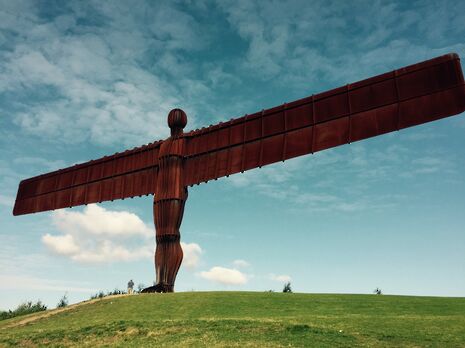The North-South divide ignores our country’s valuable middleground
A distinct Midlands identity is often lost amongst the fervent North-South rhetoric of Cambridge, writes Lucy Tiller

Freshers’ Week is like being put in a washing machine with the two pronunciations of the word ‘scone’. ‘Pick a side,’ the world screeches. ‘Align yourself immediately with Waitrose Essentials and unpleasant house prices, or rusting pickaxes and post-industrial decay.’ This is a binary choice. You have entered a Westeros-style nightmare, and there is no fence on which you are allowed to perch – unless, of course, we recognise the existence of a mystery borderland – the hazy, mythical, beige area called ‘the Midlands’.
My aggressively mediocre town is a messy melting pot of north-south stereotypes. I grew up in the comforting shadow of the local landmark, a cement factory (voted the fifth most hated building in the UK, a lukewarm failure – or success?), relentlessly coughing up its grey lungs over the suburban sprawl. For a time, two competing Greggs lay squinting at each other from opposite sides of the high street. And yet, the café over the road serves smashed avocado toast for brunch, and an evening meal is dinner, not tea. (Nobody likes Thatcher, but at this stage, that’s hardly an indicator of geography).
“HS2 powers straight past us, pausing briefly for breath at Birmingham”
The easy intermingling of different pronunciations of ‘bath’ is the friendly smoothie that comes from the ever-shifting blender of the misty borderlands, and the sudden plunge into a world where pronunciation is some sort of strident assertion of geography and politics was a surprising jerk into a world far more polarised than the one I’d previously inhabited. But the longer the feud simmers, the more I realise that the refusal to acknowledge the existence of a middle space between ‘north’ and ‘south’ is indicative of the erasure of the drizzly Midlands across the board.
HS2 powers straight past us, pausing briefly for breath at Birmingham – but for the majority of Midlanders, that’s quite a journey in itself. The ‘Midlands Engine for Growth’ is a government scheme set up in 2017 – but I hadn’t heard of it until I started writing this article, despite living in the area, and even less have I seen its effects. The government-produced ‘prospectus’ is nauseating: the clichéd pull quote, ‘Now is the time to power up the Midlands Engine’, glares out at the unsuspecting reader (I suspect I am the only one), promising 300,000 more jobs – and yet the West Midlands remains one of the worst performing regions in the country for unemployment rates. The 24-page plan to save the economy of the Midlands describes us as ‘the place to do business’, but the empty shop units plastered all over our town centre speak for themselves.
“It encourages us to view the North and the Midlands as batteries with which to power the really important bit of the country”
This document irritates me. I am irritated by the fact it’s dominated by stock images of people using industrial rotary saws to create flashy sparks rather than actual acknowledgement of the underinvestment the Midlands face. I am irritated by the empty rhetoric, and the fact ‘Midlands Engine for Growth’ isn’t nearly so pithy and exciting as ‘Northern Powerhouse’. I am irritated, too, that I don’t see any of what it promises anywhere around me. But most of all, I find it irritating that my home region is described as some sort of industrial battery, because while that might sound exciting to Rt Hon Sajid Javid MP, in truth it’s an extension of the problem with the ‘Northern Powerhouse’ rhetoric: it encourages us to view the North and the Midlands as batteries with which to power the really important bit of the country – the south, specifically London. The tuberculosis-ridden populace of the North and Midlands must take up their weary pickaxes and crawl into the mines or send their children under weaving looms to be crushed in horrific accidents, all so Kensington Waitrose can sell mini bacon quiches without disruption – but hey, it’s okay as long as the unemployment figures for those regions are low, right?
Clearly, this is all gross exaggeration – I’ve never, to my knowledge, met anyone with TB. But the fact remains that the jolly debate on the correct way to pronounce ‘scone’ during Freshers’ week is symptomatic of a broader desire to dichotomise the country along a hard north-south border, where we all must take a light-hearted side, argue for the merits of cheesy or curry chips in Gardies’ at 3am, and iron out the complex, forgotten middle region into a border easily drawn with a felt-tip pen. And when we give in to this reductive desire to dichotomise, we lose nuance, and the Midlands tumble between the cracks, becoming a forgotten, unknown wilderness of dragons and post-industrial waste.
I don’t mean to inadvertently argue that the north-south economic disparity doesn’t exist, because I would be besieged with facts and statistics proving that there is an enormous (and, rightly, much discussed) injustice in resources. I do, however, mean to warn against the playground temptation to pick a side, because that’s when areas like the Midlands start to have their identity eroded, and with erosion of identity comes erosion of funding and opportunity. Let’s celebrate, then, the oft-forgot Midlands, cement factories, Coventry-esque brutalism and the glorious Brummy accent – for acknowledging their existence is the first step to improving quality of life there
 News / SU reluctantly registers controversial women’s soc18 December 2025
News / SU reluctantly registers controversial women’s soc18 December 2025 News / Dons warn PM about Vet School closure16 December 2025
News / Dons warn PM about Vet School closure16 December 2025 Features / Should I stay or should I go? Cambridge students and alumni reflect on how their memories stay with them15 December 2025
Features / Should I stay or should I go? Cambridge students and alumni reflect on how their memories stay with them15 December 2025 News / Cambridge study finds students learn better with notes than AI13 December 2025
News / Cambridge study finds students learn better with notes than AI13 December 2025 News / Uni registers controversial new women’s society28 November 2025
News / Uni registers controversial new women’s society28 November 2025










